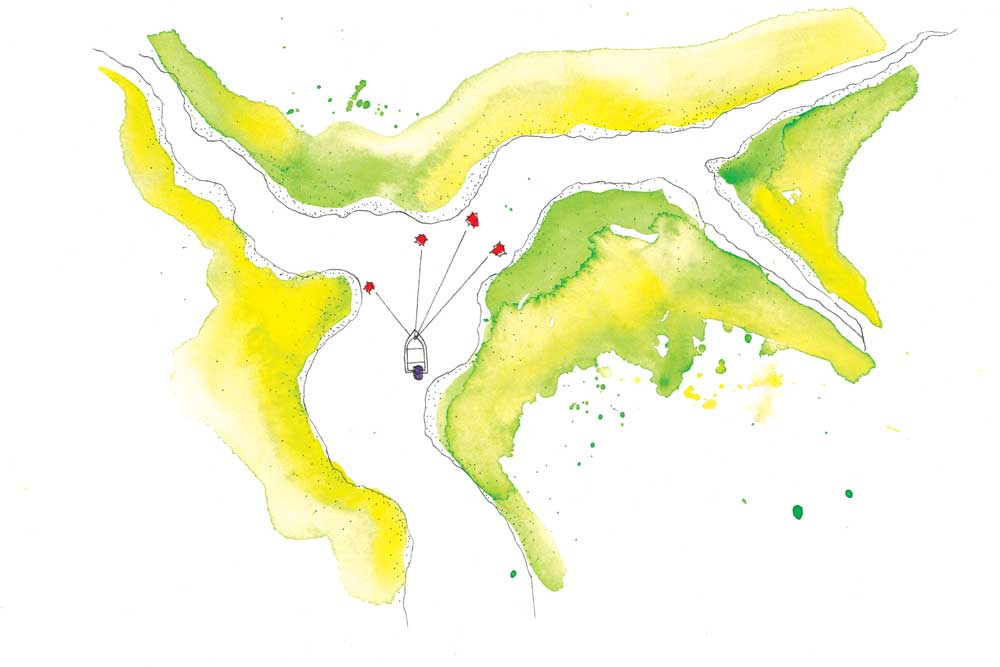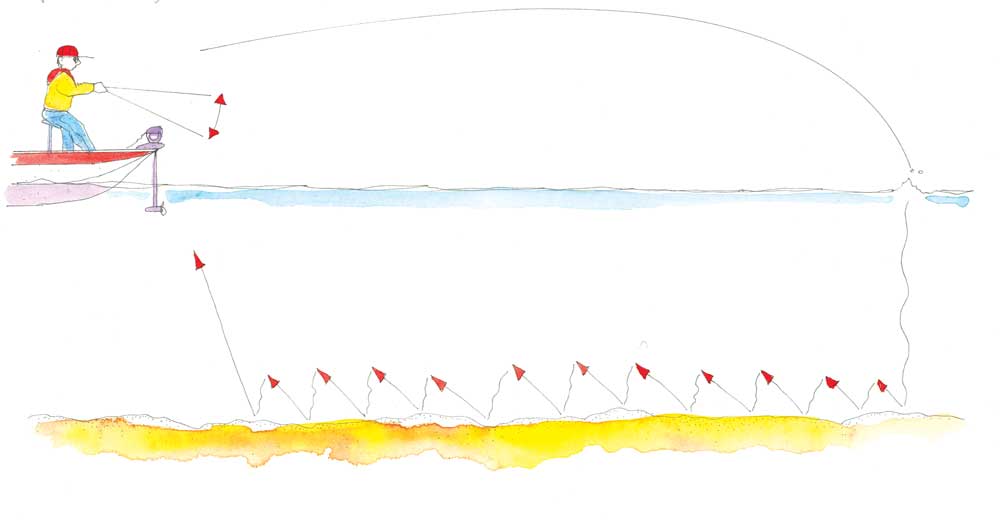Quick Links
Mangrove jack boast numerous appealing features, all of which contribute to their status as truly one of this country’s most awe-inspiring sports fish.
Jack features
Jacks are a beautiful fish and the iridescent deep purple they often acquire, even when living in heavily turbid water is a feature that very few other fish exhibit. They have a great fighting ability and they will mostly hit a lure and power back into their snag. Even small jacks can, and often do, pull line from heavy set drags. Fish of less than half a kilogram can still manage to find their way back into the snags.
They have dentures that will easily penetrate scales, flesh, and bone. This attribute, combined with a bite reflex, which is actually quite frightening, are two of the main factors that attract me to these tenacious scrappers.
Where jacks differ from many other species, is in their feeding process. They more often than not swim out from their snaggy lair, at high velocity, turn, and as they swiftly gather speed, smash your lure on the way back into the snag. Newcomers to northern creek exploits, or even those tasting man-made channel fishing around the Gold and Sunshine coast for the first time, are often caught off guard, resulting in lost leaders, lures and fish.
Casting
Needless to say, targeting jacks around mangroves requires pinpoint accurate casting. Lure casting is what fishing for jacks is all about as you must reach in and as close to the snags where the jacks are living.
Trolling techniques, while they will occasionally snare a mangrove jack, they’re generally much less effective than casting.
Tides and the tide phase is a major contributing factor as to where in the creeks and rivers these bruisers will be situated. During a half tide, either side of full, schools of fish will congregate under mangroves and fallen trees that jut out into the centre of the creek. An hour either side of high water can be extremely challenging as the mother lode of fish will have moved up into the very back of the mangroves and undercut banks waiting for mullet, herring, or gar to seek shelter in the shade from the same feature.
I've often observed numerous mangrove jacks, ranging from hand sized fish to belters well over 50 cm, weave their way nonchalantly in and out of the labyrinth of mangrove roots. What is interesting is the fact these fish appear to be sharing their tangled web of underwater flora with a mix of Archer fish, gar, and mullet.
The baitfish stayed away from the extreme back of the snags, as this belonged to the jacks and a sprinkling of fingermark bream. The baitfish are smart enough to position themselves within the shade of the trees but far enough out not to become jack fodder.
It seems as if there was an invisible barrier or boundary that only a few unsuspecting baitfish crossed. When one of the baitfish dropped their guard and moved too close to the mangrove roots, they were quickly demolished by one of these highly efficient predators.
Use a mix of retrieval styles with the standard long draw and drop working well on most occasions. When the fishing shut down we found the ultra small hops and extended pauses produced strikes when everything else failed (See Tech Tip – Short Hop (long pause).
Tackle
Tackle for jacks has come a long way over the past 30 years. Strong main lines and leaders are paramount if you want to give yourself a chance at extracting jacks from snag-riddled creeks. Thin braided lines make casting remarkably easier than with thick mono type lines of the past.
Twenty or thirty pound breaking strain is fairly standard these days, and even then, it isn’t always heavy enough to turn a rampaging mangrove jack heading back into the snags.
Some anglers swear by 50 lb as they explain that lure loss becomes too expensive with 30 lb main line.
Sometimes it’s best to run 30 lb main line with a 60 lb fluorocarbon leader when targeting big jacks, with around four kilograms of drag on the reel.
My standard braid to leader knot has been the Slim Beauty for a number of years and this has proven itself time and time again. However, it is a bulky knot and this becomes even more problematic when using heavy leader in excess of 40 lb breaking strain.
If you’re fishing with 50, 60 or 80 lb leaders I would opt to use an FG knot instead. Basically the FG is a tension knot so tight wraps are imperative for it to stay intact. This characteristic also makes it a thin profile knot with minimal bulk. It travels smoothly through the guides on each cast before passing smoothly when wound back onto the reel. In addition, the strength of the FG knot, when tied correctly, was a standout feature.
Many times unstoppable fish have taken my lure deep into the snags and in each instance my knot held strong. The 60 lb leader broke before the knot did.
Tides
Tidal flow is critical for jacks in creeks and the saying, ‘No run, no fun’, is correct. A receding tide can produce some of the hottest bites as baitfish are forced off the flats and from within the sanctuary of the thick mangroves and out into more open water, where they are easy prey for predators. The last hour or two before low tide is what I consider prime time. When baitfish are forced out into open water with only minimal cover, meaning less water between them and the jacks.
Also during low tide there is little to no water under the mangroves. This means they are forced to relocate temporarily. Predatory jacks use this opportunity to hunt. On a recent trip up north, we had several hot sessions just before dead low tide, when schooling jacks pushed into the middle of a couple of small creeks and held in trenches, hugging tight to the bottom. At first these fish were difficult to target, as diving hardbodies don't get down deep enough. A strategic switch to soft vibes paid dividends as this genre of lures proved the downfall of numerous quality jacks.
Final Word
When targeting jacks in creeks it pays to have a mix of lure styles including hard bodied divers, soft plastics, bibless minnows and soft vibes. Each lure style has its place and application around various types of structure. Remain flexible in your approach and try different retrieval styles when the stock standard approach is not delivering results.
In addition to their unparalleled pound for pound, fighting ability and their lure destroying teeth, they are one of the best eating fish available. If you have never targeted mangrove jack you are doing yourself a huge disservice. So what are you waiting for? Start planning that trip to a northern creek where you too will become totally addicted to one of the best sportfish in Australia.
TECH TIP – CASTING AROUND CREEK JUNCTIONS

When fishing a run out tide locate a prominent junction where either a major creek enters the main body of water or where the creek forks into two. Anchor up in the middle of the main body of water, positioning the boat downstream from the junction. Avoid making too much noise when deploying the anchor, particularly in shallow water creeks, as this will spook both baitfish and predators. Proceed to make casts upstream, concentrating around areas that will provide shelter for baitfish and where the current flow is diverted. Mud banks, prominent snags that jut out into the main body of water, rock bars and clusters of overhanging mangroves are good starting structure to concentrate retrieves around. Another prime target zone is where the current velocity is slowed. These are best identified by back eddies and parts of the creek where the water turns over on itself.
TECH TIP – LONG DRAW

When using soft vibes, start with the long draw style retrieve.
Cast out and allow your lure to sink until it connects with the bottom.
Gather up the loose line and then lift your rod tip from water level to around 2 o’clock.
Now move your rod tip back to near water level while gathering up your line (ensure you keep a taut line while retrieving the loose line so that you stay connected and can feel any light taps or ticks on the business end).
Note - Although jacks are highly aggressive fish when they are in a passive or neutral mode their bites can be surprisingly subtle so be alert and if in doubt, strike at anything you think may be a bite.Once your lure is back on the bottom allow it to rest for a second or two before imparting another lift.
Continue this process for the duration of the retrieve.
TECH TIP – SHORT HOP (LONG PAUSE)

When the fishing has gone quiet and the bite slowed substantially, a more subtle retrieve style is needed. We have found the Short Hop (long pause) to be a worthwhile technique to have in our weaponry.
Cast out and allow your lure to sink until it connects with the bottom.
Gather up the loose line and then lift your rod tip from water level to around 4 o’clock. This is best executed by a small upward flick of your wrist holding the rod. Your rod should act as a lever, pivoting in your hand, with your wrist only moving a few centimetres each time.
Now allow your lure to sink back down to connect with the bottom.
Pause for three seconds before imparting another small wrist flick.
Note – it is important to keep any upward movements smooth and gentle. Any quick, jerky movements may result in the vibe twisting around on itself and tangling the hooks either on the lure or on the leader.Continue this process for the duration of the retrieve.
When using this technique, experiment with the length of your pause. At times a pause of six seconds or longer can result in curious jacks nailing your vibe. Those fishers who have used ‘dead sticking’ methods for shut down bream will quickly adapt to this technique and use a variety of pause lengths on different retrieves.


